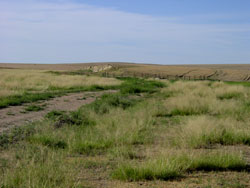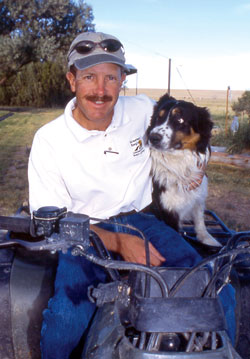Hope for the Best, But Plan for the Worst
Recent rounds of severe drought across western rangelands have brought home the critical need for management strategies during times without rain.

For many, the knee-jerk drought strategy becomes a desperate attempt to keep the number of livestock stable no matter the lack of feed. After all, a banker needs to document a borrower’s number of sheep, goats or cattle, not how much flesh the livestock carry. This crisis mentality often leads to degraded rangelands, lower birth rates, fewer pounds to sell and financial stress.
Instead, a more sustainable drought plan includes a two-pronged approach: protect the soil while maintaining a modest income over the long run.
A land manager can not protect the soil in one year. It takes ongoing effort to build organic matter in the soil and vigorous plants that can withstand the tortures of drought—including the drying winds and scorching temperatures that show up when the rain doesn’t.
Mark Frasier runs 400 cows and 3,400 yearlings on his 29,000-acre Woodrow, Colo., ranch. He rotates his cattle through 190 pastures, spreading nutrients, trampling old stubble and guaranteeing rest to keep the grasses healthy.
“The cattle recycle nutrients and organic matter back into the soil, which helps the ground retain moisture,” says Frasier, who serves on Western Region SARE’s grant-making council. “We can’t say when we are going to get rain, but we can prepare ourselves so that our soil is receptive and the plants are healthy enough to respond when we do.”
The key to distributing livestock and providing enough rest—plants need more rest during dry periods—is reliable drinking water. Pipelines, wells and spring developments cost a hefty investment at first, but the payback comes in stronger—and more—grass.
With his investment in pipelines and a one- to three-day rotation system, second-generation rancher Frasier now runs more cattle on better grass. During Colorado’s worst drought in 250 years, Frasier had to de-stock his ranch only one year.
“We’re seeing a healthier landscape and we are just starting to increase the number of cattle we graze,” he says. “Grazing more cattle on the same resource is going to have an economic advantage.” Frasier, a devotee of Holistic ManagementTM, says his improvements have lowered his cost of gain from 35 cents a pound to about 11 cents.

Colorado rancher Mark Frasier. Portrait by Ron Daines
Planting pastures with drought-tolerant, introduced species will protect native range during a drought, too. So will moving livestock to rented pasture while the range needs rest. Moving livestock to grass is almost always less expensive than moving grass to the livestock.
Frasier also maximizes the second prong of sustainable drought management: optimize long-term income without sacrificing the range. Consider selling calves, lambs or kids, but by selling lighter weight offspring early, culling the base herd more severely or selling the base herd before a severe drought drops prices and then renting out pasture. Tax incentives can help producers buy a herd back after the drought ends.
While the best-laid plans sometimes go awry, the best drought strategy is to plan today for tomorrow’s dry weather. The operative phrase on western rangelands is not if a drought comes, but when it comes.
